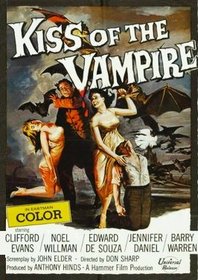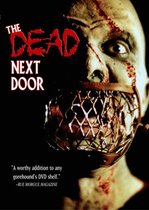Our editor-in-chief Nate Yapp is proud to have contributed to the new book Hidden Horror: A Celebration of 101 Underrated and Overlooked Fright Flicks, edited by Aaron Christensen. Another contributors include Anthony Timpone, B.J. Colangelo, Dave Alexander, Classic-Horror.com's own Robert C. Ring and John W. Bowen. Pick up a copy today from Amazon.com!
The Kiss of the Vampire (1963)
Hammer Film's Kiss of the Vampire is a classic of the genre. Its historical place -- released in the early 60's during the spate of vampire films in the wake of Hammer's hugely successful 1958 version of Dracula starring Christopher Lee -- gives it the characteristically Hammer atmosphere between the more grandiose Universal horror the 30's and 40's and the more intimate, in your face bombast of the 70's and beyond.
Directed by Don Sharp (Rasputin: The Mad Monk, Psychomania), Kiss of the Vampire begins strongly. The first thing we see is a funeral procession. Both the direction and cinematography in the opening are absolutely stunning. Sharp manages to show an activity that we've seen in at least 200 other horror films from a completely fresh angle. He also takes his time, giving the funeral more emotional weight --even at such an early point in the film; we don't even know who any of the characters are yet. Alan Hume's camera work conveys a very deep three-dimensional setting, and manages to be beautiful, cold and bleak at the same time. Our first glimpse of Professor Zimmer, elevated and at a distance from the funeral party, is haunting, and equally effective is the shock of his next action, which results in an amazingly red pool of blood.
After the titles roll, Kiss of the Vampire changes mood, but doesn't lose any quality. Where the opening featured a stark pallette -- a foreshadowing and foreboding of things to some, Sharp goes with rich colors for the remainder of the film. It's an unusual combination, but it works elegantly. The contrast gives the rich colors an ominousness they wouldn't otherwise have.
The main thrust of the plot concerns late nineteenth century English newlyweds, Gerald and Marianne Harcourt, on their way to honeymoon. In Bavaria, they become lost and run out of gas in a virtual Bistritz (the Transylvanian town where Jonathan Harker first ends up in the Dracula novel). They find shelter at the Grand Hotel, a parallel to the novel's Golden Krone Hotel, where odd things begin to happen almost immediately.
When the wealthy town resident, Dr. Ravna, invites the Harcourts to dinner before they've even had time to unpack their bags, they may be destined for doom, as the Ravna family has roots in evil. Only Professor Zimmer may be able to save them.
Most of Kiss of the Vampire is territory that we've seen before (and many times since) the film's release. If you've seen as many vampire films as I have, you'll be able to guess many plot developments -- at least a few minutes in advance. In one sense, Kiss of the Vampire is simply a reworking of Bram Stoker's novel. But the main reason you watch a film like Kiss of the Vampire at this date isn't to be exposed to an unprecedented plot -- it's to relish in that Hammer style, which at its best, as it is for most of this film, is eerily atmospheric even during the most mundane of activities.
Still, Kiss of the Vampire does enter more unusual territory as it goes along, and the ending is fairly unprecedented. Unfortunately, Sharp, at the same time, can't consistently maintain the quality of the opening, and Kiss of the Vampire just slightly loses focus enough, and the ending is just slightly too abrupt. There are a couple minor problems with the effects at the end -- the effects over Ravna's castle work well enough, but the effects inside look a bit to cheesy to modern sensibilities. However, great acting saves the scene.
Although it remains delightfully creepy throughout its length, you'll also marvel at the artistically refined sets -- especially Dr. Ravna's home. I also can't remember many films where all of the female leads are so gorgeous.
As a Hammer film, Kiss of the Vampire contains almost no gore (except for that pool of blood that I mentioned from the first scene). It also characteristically moves much slower, and courtlier, than most younger genre fans will be accustomed to. These aren't flaws, of course, but just warnings to those of you whose horror experience to this point consists mainly of Scream, Evil Dead and The Texas Chain Saw Massacre that you need to adjust your settings, and maybe lay off the sugar a bit, before you sit down to watch the classic films of this and earlier eras.
Kiss of the Vampire has a relatively tight script, one of the many penned by son-of-Hammer honcho Anthony Hinds, a typically effective score by James Bernard, quality performances, and both bathes in tradition and extends it. Those are all good reasons to seek this film out, but the best is that restrained but prolonged tension and ghostly ambience that Hammer did so well. While there are films that achieve it as well as Kiss of the Vampire, few achieve it better.
Trivia:
A television version, retitled Kiss of Evil, trims most of the blood, and inserts scenes of a local family and the effect the vampires have on them.
An unofficial remake of The Black Cat (1934).








